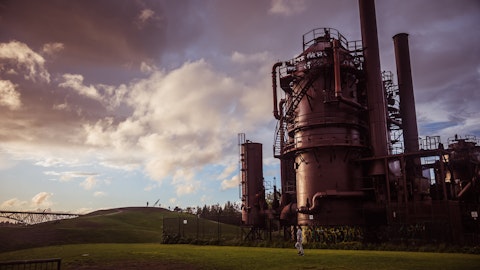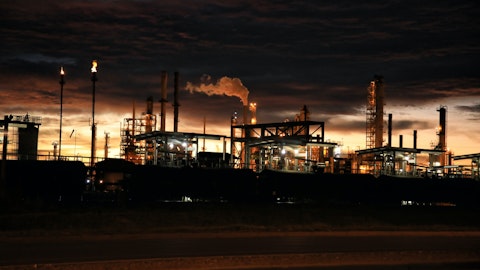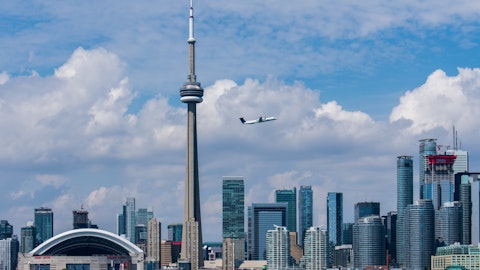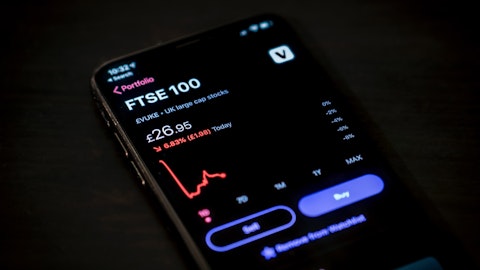Kris Smith: Yes. Our focus in 2023 is in the upstream and particularly in the oil sands basin. It’s continuing to drive — leveraging the scale around regionalization. And so the contractor reduction is a great example of that because it’s the ability to leverage across the entire asset base and optimize and drive down the contractor workforce, as an example. We’re continuing to work on that regionalization strategy around services, around materials and supplies. And then the other piece is, and Peter was talking about earlier in his answer, on the question around Fort Hills is we’re seeing this opportunity to continue to drive this integration between the assets because it increases reliability and how we manage even things like maintenance events.
So as we’re managing, for instance, maintenance in Syncrude, we now have the added benefit that we look at, well, if certain things are down for maintenance, it doesn’t mean necessarily we’re slowing the mine down. We can now move that bitumen and bring that bitumen into the base plant. So we’re going to be focusing on more and more opportunities like that. I’ve been pleased with what I’ve been seeing with the assets. An example would be Firebag as well. We had a Q4 production record. So we’re seeing increased reliability across the assets. But really, our big focus is in the mine upgrading space that Peter is leading because there’s a lot of opportunity, both on how we’re managing cost in the business as well as how we’re optimizing the production amongst the assets.
Greg Pardy: Thanks very much.
Kris Smith: Thanks, Greg.
Operator: Thank you. And our next question comes from the line of Doug Leggate with Bank of America.
Doug Leggate: Thanks. Good morning, everyone. Guys, I wonder if I could address the dividend. I know you’ve announced it last quarter, but with the the visibility you have today, one of the key things behind the strategy we laid out a few years ago was to drop the breakeven. So with all the moving parts that we’ve seen with Fort Hills and the kind of reset you’ve had, where do you think that breakeven progress sits today relative to what you laid out? I guess what I’m asking is what’s the breakeven to cover your dividend today? What’s the headroom for additional dividend increases?
Kris Smith: Go ahead, Alister.
Alister Cowan: Yes, I’ll take that one, Kris. Thanks for the question, Doug. Obviously, lots of moving parts here. The dividend has been going up and as we progress improvement in our operations. I would say, as we said and look at it today, corporate breakeven for sustaining capital and dividend is low to mid $40 WTI. It’s higher than obviously we had targeted. But it is competitive amongst our integrated peers. As we work through our performance improvement plan to drive down cost and improve reliability and production over the long-term, we are focused on driving that back then to our longer-term target of the mid-$30. The biggest factor in that really and the opportunity is the main improvement plan, particularly in Fort Hills.
And I would see as we work through those near-term mine constraints and get into the north pit at the largest and final pit, we would expect to see a significant improvement in Fort Hills. That will help us drive down the overall corporate breakeven.
Doug Leggate: Okay. I will continue to watch it. I guess, my follow-up is buried in the numbers, I guess, there was a comment about the increase in decommissioning in restoration provision. I’m just wondering if you can walk us through what the back story is there, how this has come about, whether we should expect that whether this is the end of the story, or we should expect that to continue to evolve. And I’ll leave it there. Thanks.
Alister Cowan: Yeah. Thanks, Doug. I mean you’ve heard us talk about the challenges of water return remediation, which is an industry-wide challenge anybody would mind up of slit. And it’s certainly one that we’ve been talking about. There will be in conversation discussions with the two levels of government in Canada and also the First Nations to resolve. I’d just remind everybody, we’re the only industry in the world that is not allowed to return any treated water back to the river. And that would include all the rainfall that falls on our sites. So everybody in the industry is actually focused on resolving this. Obviously, we have a larger volume than anybody else because we’ve been at it for far longer than everybody else.
As we go through our normal process In Situ, we update our estimates to manage that water return challenge. And specifically, this year, that would include incorporating higher rates of inflation on future costs In Situ for up to 70 plus years into the future. So that really is the driver behind the increased ARO liability that you see in the financial statements. Everybody industry has it, and that’s why we’re all so focused on resolving that water return challenge with governments and our peers.
Doug Leggate: Just to be clear, Alister, for clarification, what’s the cash out, the cadence of the cash out for that incremental liability?
Alister Cowan: Yeah. Most of that, Doug, will come in after mine closure and ranges from late 2030s to 2070 to 2080.
Doug Leggate: So it’s very long dated. Got it. Thank you.
Alister Cowan: That’s very long dated and there’s no near-term increase in cash outflow.
Doug Leggate: That’s what I was trying to get to. Thanks so much Alister. That’s great. Thank you.
Operator: Thank you. And our next question comes from the line of Neil Mehta with Goldman Sachs.
Neil Mehta: Good morning team. I’d like to kick off here on capital returns and as you said, last couple of years, you’ve been aggressive in repurchasing shares and reset the dividend. Just as you look at 2023, can you give us a sense of how much capital can be returned to shareholders and with commodity prices coming off a little bit, what’s your confidence interval about making that pivot to 75% from 50% of cash back?
Alister Cowan: Thanks for the question, Neil. So our view is that we’re still in a constructive pricing environment, obviously, not going to be what we saw in terms of the records of 2022. But we feel that what we see right now in the pricing environment, assuming it continues to hold through the balance of the year and our own operational plans. Our intent is to pivot to the 75%-25% here towards the end of Q2 — sorry, end of Q1 and as we’re starting to see the debt start to get even closer to those long-term targets that we set out quite a while ago. As you know, we’ve made a lot of progress on those debt targets relative to where we thought they would have been 18 months ago. And so right now, our plan is to continue to move to that 75%, 25% in that time frame unless something radically changes in the business environment.
Neil Mehta: Yes. Thanks for that. And the follow-up is around the safety journey that you’re on. Maybe you could spend some time, Kris, talking about your perspective on that, how can we, as an investment community, evaluate where you are in that movement back towards where you want to be? And any comments around Commerce City as it relates to that as well?




